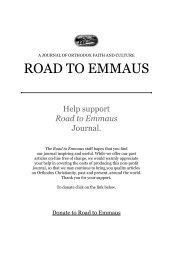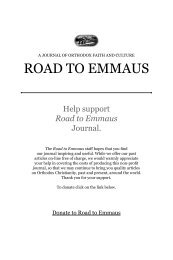RTE No 20 Interior - Road to Emmaus Journal
RTE No 20 Interior - Road to Emmaus Journal
RTE No 20 Interior - Road to Emmaus Journal
Create successful ePaper yourself
Turn your PDF publications into a flip-book with our unique Google optimized e-Paper software.
<strong>Road</strong> <strong>to</strong> <strong>Emmaus</strong> Vol. XII, <strong>No</strong>. 2 (#45)CROAGH PATRICKthat had survived the Middle Ages are abandoned. There is nothing left <strong>to</strong>the Irish of their traditional religion except going <strong>to</strong> holy wells and climbingCroagh Patrick. From the 1780s onwards, many of these restrictions weregradually eased and the British Government even funded the new CatholicUniversity in Maynooth. Full Catholic Emancipation came in the 18<strong>20</strong>’s.<strong>RTE</strong>: How many of the Catholic clergy survived?MICHAEL: By the end of the 17th century, huge areas have none at all. In fact,in 19th-century Connemara when Irish-speaking evangelical Protestant missionarieswere swarming all over the place, people had been without churchesand sacraments for so long that they didn’t know the difference. Theyknew that earlier there’d been Irish-speaking priests, so they were quitehappy <strong>to</strong> go <strong>to</strong> a Protestant mission <strong>to</strong> get some food and go <strong>to</strong> the servicesuntil the difference was pointed out <strong>to</strong> them.Reverend MacManus, a Protestant minister (and ex-priest, which wasquite unusual) described their awakening: “We were making great inroadswith the Joyces of the Inagh Valley”… until someone must have poisoned theatmosphere against him, and <strong>to</strong>ld the Joyces that he wasn’t a Catholic priestat all, but a Protestant minister. They didn’t know what a Protestant ministerwas, but he was obviously something he shouldn’t have been. (laughter) OnAran, when they were <strong>to</strong>ld that he wasn’t a real priest, they wouldn’t takehim off, so he wandered the island for weeks, looking for a way back <strong>to</strong> themainland.In the 16th and 17th centuries, only the pilgrimage sites continued as anoutward religious practice; otherwise there’s <strong>to</strong>tal war. When the Irish brokethe “rules” the English would launch cruel punitive raids, and all hell wouldbe unleashed on <strong>to</strong>p of them. Defeated Gaelic chiefs would often sign a deal:no more raiding, no more attacking English crown land or the English allies.But if a Gaelic lord isn’t raiding, he’s not really a Gaelic lord. After a fewyears, they’d get bored and break out in rebellion. If the rebellion was strongenough, like that of Grace O’Malley, the Irish pirate queen, they’d be offeredanother pardon by the English. So there was a succession of surrenders, rebellionsand pardons, until finally the English would go in and garrison theplace, taking all of the land. Our Irish his<strong>to</strong>ry is often written from a nationalistpoint of view that there was a pre-conceived plan by the English <strong>to</strong>colonize the whole country, but often, the confiscation was by default. Thesemountain areas of Connemara and parts of Mayo survived the longest. Theywere so isolated that even some paganism survived in remote corners; therewas a medieval Ireland still clinging on.The Irish Language<strong>RTE</strong>: Speaking the Irish language was also forbidden under the English,wasn’t it? Can you say something about <strong>to</strong>day’s Irish/Gaelic speakers?MICHAEL: Yes, a massive effort was made <strong>to</strong> anglicize Gaelic society, and aknowledge of English became necessary in order <strong>to</strong> interact with the state orthe legal system. Linguistically, Irish is the same language from Scotland allthe way down. It is a British language as well as an Irish language, but a differentdialect. Today there are probably no more than 60,000 who speak itnaturally every day of the week, and half a million more who can speak it, butdon’t use it as their primary everyday language. Roughly half of Connemararemains Irish speaking.I worked in London on building sites when I was 17. This was 1976, and Iremember that one of the men on the site was very quiet. Donegal, we used<strong>to</strong> call him, and Donegal wouldn’t say a word <strong>to</strong> anyone. But one day I hearda man from Spiddal, a village south of here, talking in Irish and I said inIrish, “How are you, where are you from?” When Donegal heard he ran over<strong>to</strong> me and said, “You’re able <strong>to</strong> speak.” He’d lived in London for a few yearsand had never learned English and didn’t want anyone <strong>to</strong> know because themost embarrassing thing within an immigrant community is not <strong>to</strong> speakthe host language.There were a lot of Irish people in London from Connemara, Aran, andDonegal that arrived with so little English that they kept themselves withinthat community. There’s a very large Irish-speaking community in London,as there is in New York, Bos<strong>to</strong>n, and Chicago, but they tend not <strong>to</strong> pass it on<strong>to</strong> the next generation. There was huge antagonism <strong>to</strong>wards Irish languagefrom the 17th century onwards in Ireland. The Irish-speaking Lords weregone, as was the clergy, so it simply went down the social order.There’s a wonderful early 18th-century account of one of the Irish O’Connorchiefs in exile in Austria-Hungary. He is meeting the Archduke in Vienna,and an old Irish émigré chief is also there who greets his two young cousins,who had just come from Roscommon, in Irish. They are embarrassedand say, “We don’t speak the old language anymore.” The archduke replies,“What sort of culture are you that you don’t even speak your own language?”3435










